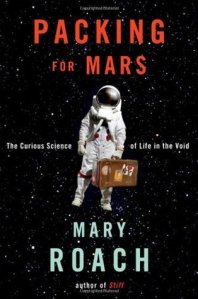 Having heard several approving reviews of Mary Roach’s Packing for Mars, subtitled “The Curious Science of Life in the Void”, I had expected to like the book. The subject matter – a look at the “less publicised” elements of space travel – also sounded as though it would appeal. Of course, I have been there before: reading a popular, and populist, book on the Space Race and finding it a poor read. That book was Moon Shot by Alan Shepard and Deke Slayton – see here.
Having heard several approving reviews of Mary Roach’s Packing for Mars, subtitled “The Curious Science of Life in the Void”, I had expected to like the book. The subject matter – a look at the “less publicised” elements of space travel – also sounded as though it would appeal. Of course, I have been there before: reading a popular, and populist, book on the Space Race and finding it a poor read. That book was Moon Shot by Alan Shepard and Deke Slayton – see here.
I soon found myself thinking the same of Packing for Mars.
The “curious science” alluded to in the title is, basically, all those delicate subjects NASA and the like are reluctant to discuss openly: fear, sex, urination and defecation, vomiting, food, etc. Packing for Mars discusses its topics with a combination of cited documents and anecdotes (though it’s careful to label and attribute the latter). Unfortunately, some of the facts are just wrong. The first Briton in space was Helen Sharman not “Helen Sherman” (p 47). The “world’s first rocket” was not built by the Nazis (p 87) – as any half-decent book on rocketry will confirm. And as for this: “‘When technical perfection of the steam engine made the development of railways possible, scientists were afraid that the velocity of the trains would exert harmful effects upon the human passengers.’ The quote comes from an aviation medicine text published in 1943. (Locomotives at that time could not exceed fifteen miles per hour.)” (p 94). At first pass, that reads as though trains could not exceed 15 mph in 1943. Which is complete rubbish – the world speed record for steam trains, 125.88 mph, was set by Mallard in 1938. I believe Roach actually means that when railways were first built, the trains were limited to 15 mph. But even that is not true – the first successful railway line in the world was the Stockton and Darlington Railway, which opened in 1825. In 1829, Stephenson’s Rocket set a speed record of 29 mph.
Perhaps that’s being too picky – although I see little point in a non-fiction work that gets its facts wrong. True, Roach does seem less concerned with background facts than she does in presenting amusing stories relating to the book’s topics. There are, for example, several passages quoted from astronauts’ autobiographies and the Apollo transcripts, describing incidents such as floating turds in the Apollo CM, leaking or ill-fitted urine-collection condoms during Gemini missions, or astronauts having trouble keeping down the contents of their stomachs.
None of which is to say that Packing for Mars is an entirely uninteresting read. There is perhaps a somewhat negative tone, since the book focuses chiefly on failures and embarrassments. Unfortunately, this doesn’t make the astronauts and scientists appear more human, it actually feels as if the book is trivialising their achievements. Admittedly, Packing for Mars is, as suggested by its title, chiefly concerned with the difficulties associated with a mission to Mars, and the incidents it reports are used as illustrations in support of that thesis. Unfortunately, those difficulties as presented appear unsurmountable, which only further cheapens any existing achievements in space and space-related activities.
It doesn’t help that the entire book is written in a style which attempts to make a joke of everything. It is possible to talk about toilets and faeces without giggles, though Roach seems incapable of doing so. Sadly, the humour in Packing for Mars is mostly sophomoric, especially in the footnotes. This has the side-effect of giving the prose a patronising tone, and this works against Roach’s arguments. (A tendency to explain things the reader should all ready know, also adds to the patronising tone.)
Perhaps it’s just me, perhaps I’m not the right audience for a populist science book on this topic. I find the jocular tone and the breezy style of such books annoying. It undermines their authority – and, as a reader, I want to be certain that what I am reading is factual. I want to learn something new, not something incorrect or inaccurate. I need to be confident the author is an expert in the topic under discussion – even if that expertise is only the product of research or interviews. Otherwise, it might as well be fiction.
Packing for Mars could have been so much more – a serious study of the hurdles facing a crew travelling to Mars, for example. Instead, it’s an overly flippant commentary on some of the factors affecting such a mission. Disappointing.
Packing for Mars, Mary Roach (2010, WW Norton & Company, ISBN 978-0-393-06847-4, 318pp + acknowledgments, time line and bibliography)